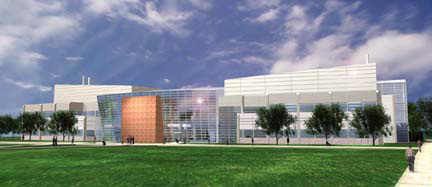Chemical Engineering Facilities
New Building Expansion
The School of Chemical Engineering at Purdue University has a vision for the future: To continue to be the premier source of well-educated, well-prepared chemical engineers by continuing to educate students using innovative classroom and laboratory technologies and by fostering an environment to continue to inspire leading-edge research.
To realize this vision, the School has built a five-story addition on the current building, is in the process of remodeling the existing building, and equipping the addition and remodeled facility with state-of-the-art technologies and high-performance instrumentation. Designed to be a teaching and research facility equipped with leading-edge technologies and high-performance instrumentation and equipment, this facility will meet the current and anticipate future learning and research requirements of ChE students and faculty. (Visit our Champions of Excellence site to view our new building addition)
Discovery Park
The Lilly Endowment awarded Purdue University a grant of almost $26 million for Discovery Park, a complex for advanced interdisciplinary research and education. Purdue will leverage the grant and state funding with existing university funds, private donations and federal research support to create the $100 million park. Initial plans for the 40-acre site on the west edge of campus call for centers to house research in nanotechnology, bioscience/engineering and e-enterprise. The park also will include an entrepreneurship center to help transfer research findings into products and services.
Birck Nanotechnology Center
 Just as antibiotics, the silicon transistor, and plastics affected nearly every aspect of society in the second half of the past century, nanoscale science, engineering, and technology will transform the 21st century. The Birck Nanotechnology Center (BNC) at Purdue University will be a leading-edge national center advancing the frontiers of nanoscale research.
Just as antibiotics, the silicon transistor, and plastics affected nearly every aspect of society in the second half of the past century, nanoscale science, engineering, and technology will transform the 21st century. The Birck Nanotechnology Center (BNC) at Purdue University will be a leading-edge national center advancing the frontiers of nanoscale research.
The Birck Nanotechnology Center will be housed in a new $54 million state-of-the-art building to be constructed in Discovery Park on the western portion of the WL campus. This building will be one of the most advanced facilities in the world, with specialized laboratories for nanoscale chemistry, physics, and biology; semiconductor-grade cleanrooms; and office space for faculty, post-docs, and graduate students from various disciplines across campus. Even though the building will not be occupied until spring 2005, the Center is being organized now. Operation will be supported over the first three years by a $9 million grant from the Lilly Foundation, and the majority of these funds will be used to purchase new equipment for nanoscale research. A smaller amount will also be available as start-up funding for promising new research concepts in nanotechnology. Members of the BNC will be eligible to apply for equipment grants and research start-up grants from the BNC, beginning immediately.
Bindley Bioscience Center
 The Bindley Bioscience Center initiates and facilitates multi-investigator, multi-disciplinary research that blends life sciences and engineering. State-of-the-art research programs focus along strategic lines that advance proteomic science and technology, bionanotechnology and biomicrotechnology, spectroscopy-microscopy for cellular and tissue imaging, tissue engineering, and bio-informatics.
The Bindley Bioscience Center initiates and facilitates multi-investigator, multi-disciplinary research that blends life sciences and engineering. State-of-the-art research programs focus along strategic lines that advance proteomic science and technology, bionanotechnology and biomicrotechnology, spectroscopy-microscopy for cellular and tissue imaging, tissue engineering, and bio-informatics.
Researchers in the Center already are at work designing tiny electronic devices that use proteins, DNA, and even living cells to rapidly detect substances in blood, air, water and food, leading the way for innovative and rapid diagnostic tools. Proteomics and cellular imaging are opening future opportunities in tissue engineering - creating materials that can mimic, repair and regenerate biological tissues and promote self-healing. These and other exciting advancements and discoveries will shape our future. We encourage your collaboration and participation as we work together to merge engineering and the life sciences in new and productive ways.

